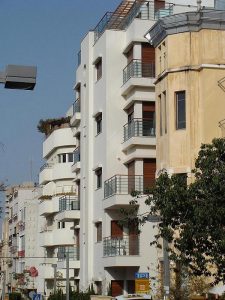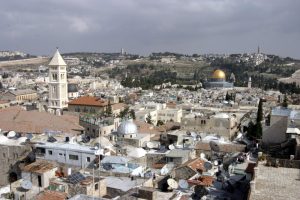No Place for Human Beings

Tel Aviv, the Bauhaus “White City”

Old City of Jerusalem
Sylvia Cohen, JFJFP signatory and lobby group member, visited Israel recently. Here are her feelings about what she found.
October 2017 zooms us through passport control at Ben Gurion airport into a parallel universe; a place where you walk through mists of confabulation and fens of denial. A place where if you have any awareness of what is happening behind the slyly fabricated curtains of propaganda, you live in a state of split consciousness, doing ordinary things with little reference to the extraordinary reality of the fifty-year, oppressive, Occupation of the West Bank, and imprisonment of the people of Gaza.
In 1967, in Israel, we were so naively happy that Jerusalem “the Golden” was opened up…. well, we were young and had been frightened, and didn’t realise that this was an annexation of land. We thought there would be a way of negotiating for peace with secure borders, ignorant of the fact that even in 1967 plans were already in place for annexing the West Bank first through military bases and then civilian settlements.
Jerusalem now is a dark and complex city – full of underlying anger and conflicts, to do not only with Jewish-Palestinian relationships but also the obsessional differentiations between levels of orthodoxy, and schools of religious thought.
We spend some time at a couple of family events where the only things mentioned about the oppressive situation point to the humanity and moral goodness of the Israeli army. It provides health care for Syrian soldiers. Everything is fine, shopping centres, restaurants, concerts. The cognitive dissonance is unbearable when you allow thoughts of what festers in the shadows of this “Light unto the Nations” that was supposed to be Israel in its initial, hubristic, conception.
The Shuk in the centre of Jerusalem on a Friday morning is busy and noisy, with the scent of baking, stalls selling food for Shabbat. The market in Hebron is silent, stalls full of goods seen only by a few guided tours. And the settlers that live abutting the market throw their rubbish over the wall. A netting has been put up over the market street, so you walk under a dark tunnel of detritus.
Any political conversation with Israelis – other than with activists – inevitably meets with the iron wall of security, which attaches itself to criticism of the Occupation. Nice, caring people – some of them even think they are left wing – who have no idea how to join up their thinking between dislike of the Occupation and their incorporation of paranoia, a useful tool of state propaganda. There is of course militancy among the Palestinians who are after all resisting an Occupation, but protest is in the main peaceful; Israel’s military strength is such that it hardly needs the settlement of the West Bank other than as a sabre rattling triumphalism, which has the added advantage of paving the road to Greater Israel. Perhaps what the Palestinians are objecting to is not so much a homeland for the Jews as a colonial expansionist state that is making their lives a misery.
Before we leave for Tel Aviv, we go to East Jerusalem to visit the Emleson Women’s Society . Driving over the invisible line between West and East Jerusalem is a short step into a completely different world, of a rough main road, overflowing rubbish bins, shops and buildings huddled together in small spaces. A deprived area, albeit one that pays its municipal taxes, just like the citizens of West Jerusalem.
Emleson Offices are situated a little way up the Jericho Road, overlooking a Jewish cemetery which covers most of the hillside below. Whenever there is a Jewish funeral the road is closed to everyone except the funeral cortege, so business has to stop. This may happen a few times a week. The road might be closed for other events too. We see Israeli settlements surrounding Jerusalem, sharp white in the soft green and brown landscape. And we see some of the Palestine enclaves that so far, barely, survive in the Mount of Olives, like beleaguered Silwan.
Emleson society itself is a women’s project dealing, in essence with the trauma of the Occupation.
Hayat tells us about the boy who was shot when he ran home from the school bus one day, hungry for his lunch. In hospital, wounded, sight damaged he told Hayat that he’d learned something – never to be hungry. He was nine years old.
Emelson has nurseries and schools, they work with damaged and poverty-stricken families, provide day care for babies whose mothers are working, support through women’s groups and help for parents who are finding it difficult. These women, all of them competent and professional, are doing the work of the municipality- without it seems, municipal support. They have no choice in the face of the suffering they see.
Tel Aviv is buzzing, highly-strung, brittle, desperately seeking a screen to the facts on the ground. I go with Karin and Annelise to a dawn shift of the Mahsom (Checkpoint) Watch: the women go to observe what’s happening at the checkpoints, and will intervene if any abuse is taking place, often to good effect. But the abuse is endemic to the situation – grown men and women being subject to the whims of soldiers – often young enough to be their grandchildren.
We go first to the checkpoint outside the town of Qalqilya in the West Bank. Only those with permits are allowed through – permits cost money, which the workers must pay. There is a whole underground business going on with permits, which I don’t quite grasp, but suffice it to say that someone is making money out of it. One man tells us that he has paid a lot of money for a permit to work, but is only allowed to go into Israel five time in a month. Permits are refused on a whim, just as delays to entry are imposed. The flow has been smooth this morning – no hold-ups. There is a mass of humanity outside the checkpoint waiting, for employment, employers, rejection. As the sky lightens we hear the call to prayer – I only wish their God would listen.
We take a ride around the West Bank – bewilderingly, these roads seem to change shape and direction, according to Karin and Annalise. The army sometimes just blocks up roads for no apparent reason, making detour and delay inevitable. We go to a couple of rural checkpoints open, haphazardly, for the farmers to go to their lands. One man tells us he has applied for a permit for his son to help him. He was refused – only one permit per family.
We go to a couple of villages to meet up with people who the women know and have helped in some ways. We also visit a Bedouin village in which the army constantly demolishes houses (only for them to be built up again). Despite this uncertain and ramshackle existence, the village has a nursery and primary school, which seem to be thriving.
In south Tel Aviv we visit three projects working with migrant workers from the Philippines, and refugees. Again, projects which are doing work which rightly is the responsibility of the municipality – although in this case, there is a little public money available. Both of these groups are in anomalous positions in terms of their status in Israel. Although migrant workers can stay as long as they have a work permit, any baby born there has to be sent back to the Philippines. At the time of our visit, refugees are neither accepted as asylum seekers, nor sent back. Now at the time of writing of course, Israel has at last taken some action – mass deportation of refugees to a country they know nothing of, and which, it seems does not want them.
And there are many Jewish Israeli activists, many of whom daily put themselves at risk both physically and psychologically in fighting for justice. They need and deserve as much support as we can give them. But there are so many who seem to be denying the reality of where they live: fifty years of Occupation; constant expansion of settlements on the West Bank; the annexation of East Jerusalem; inhumane, humiliating treatment and virtual enslavement of whole sections of society. It makes you wonder – what is this country, and who is it for?
